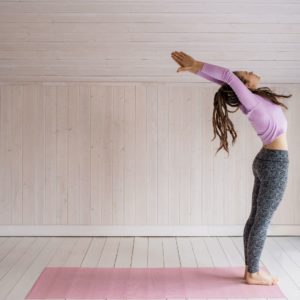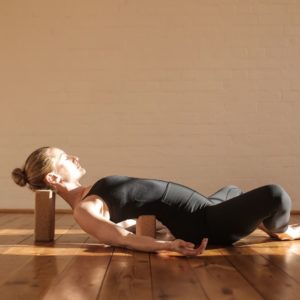
How to Maintain a Movement Practice within the Changing Cycles of Life
When it comes to exercise and Ayurveda, we tend to immediately think of yoga as the primary form of exercise. And yes, while yoga is an incredible tool and practice to incorporate into your life, it’s not always the medicine we need in the moment. That’s right, I said it: yoga isn’t always the cure! Ayurveda teaches us to flow with the natural rhythms of life. Just as we adjust our food to match the flow of our life we also need to adjust our movement with the ebbs and flow of life.
What does that mean?
This means learning how to take care of yourself throughout all of the changes that happen within your own community, family, and environment. Whether you're experiencing seasonal, hormonal, career shifts, or any other significant change, most all changes can become a determining factor in how to best fine tune your exercise. This will help to create more balance and harmony within your body and will greatly contribute to your overall emotional well being. Through careful awareness and simple changes you will be able to best tackle whatever is happening in your life.
Important factors to consider when scheduling your workout
Dosha

Vata
Given Vata’s natural tendency to be on the go, a little flighty, and often gravitating towards more movement it may be best to slow down and add in more grounding movement practices into your weekly routine. Things like tai chi, restorative yoga, meditation, massage, and walks in nature can all be really good to help harness & focus that Vata energy. For strength building focus on slow, intentional, and fluid resistance training.
Pitta
Pitta loves a challenge and can easily fall into a hard and heavy approach to working out. Pitta’s need to express their fiery energy, but too much can easily lead to imbalance and major adrenal fatigue. Make your workouts more moderate (don’t always go to your max), keep your intense workouts balanced with just as many restorative exercises, exercise in nature, and avoid exercising in the midday sun.
Kapha
Kapha is the least likely to get out of balance with excess exercise. If Kapha energy is strong, a swift jog could be the perfect cure. Full body exercises like cycling, rock climbing, running, and swimming can all help to balance Kapha dosha.
*All doshas tend to benefit from exercising during the Kapha time of day (6-10am/pm)
Hormonal cycle

Luteal/Menstrual
Leading up to your period it’s important to begin to decrease your high intensity workouts. As your body begins to prepare for a bleed week, it needs to take extra care in saving more energy for the event that’s to come. Try to focus on slower movements like restorative yoga, walking, and low-level weight training. I would recommend very little activity at all on the first day you bleed. Gradually as your energy increases you can begin to increase your activity and intensity levels. However, continue to take care in not overdoing it during this time.
Follicular/Ovulation
This is the time in our cycle when we generally feel the best and have the most energy. It’s a perfect time to focus on building more muscle because your body is more equipped for it. Add in your HIIT training, heavier lift days, hot yoga, or sweaty dance classes during this phase of the month.
Peri/Post Menopausal Years
This can be a really challenging time for many women. But, with the proper information and right support it doesn’t always have to be so difficult. As your hormones begin to change, building muscle and burning fat will not be as easy as it once was in your 20’s and 30’s. That’s why it is extremely important to focus on movement practices that will help you maintain and build muscle. Focus less on heavy cardio and more on resistance training. Walking, jogging, and hiking are all still acceptable options, but practices like yoga and weight training are going to be the most beneficial.
Time

Stress (travel, sleep, big life events)
Stress plays a HUGE role in our health. If we are overworked, underslept, or emotionally exhausted we are not going to get the same benefits or make gains from our workouts as we would when we are free from life’s stressors. If you are navigating through a lot of extra stress it’s extremely important to focus on practices that will help to ground and support you. Things like meditation, prayer, journaling, walking in nature, and spending time with loved ones are all helpful during times of stress. Be really honest with yourself about what you need. You might need a run or you may need to skip the workout and schedule a massage (on a budget? Self massage or partner massage works just fine).
Movement is so important for longevity of the body and is just as important for the longevity of the mind. Not only does it help to keep our physical form in shape, but exercise can really help to strengthen our emotional body. We need fluidity, stretching, and building to help maintain a more balanced and harmonious state of being. There is a huge growing body of research about the positive impact of exercise to the brain/body connection. It’s been proven that as little as 20 minutes of aerobic activity can lift people out of states of anxiety and other mood disorders. Movement practices/exercise causes an increase in circulation to the brain which could be a major contributing factor in turning your day completely around!
With a few small tweaks from the helpful wisdom of Ayurveda we can begin to fine tune our exercises to best support us during the unique changes and challenges that life will inevitably bring.
To dive deep into the teachings of Ayurveda, become a wellness coach, or deepen your own path to healing (or all of the above), consider joining our 2022 class of Ayurveda School. Learn more here.
